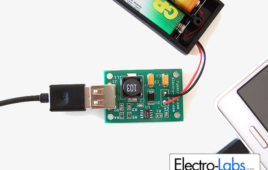Battery powered devices are all around us in daily life and we always face with low charge problems which lets us down in the middle of the day. Especially phones, music and video players, e-book readers etc. Sometimes we can’t find a mains source to plug an AC adapter or an USB port of a computer. In those cases, the battery powered USB travel charger comes to aid. It can be powered by two or three AA or AAA size batteries which you can find easily or carry with you while you are mobile. This article provides all the steps of the design and the manufacturing process of DIY Battery Powered USB Travel Charger project. We will draw the circuit, and PCB by using SoloPCB tools which are free and powerful to cover all our needs. When we finish the board, we will get the PCBs manufactured by Mass Design which has an ordering system integrated to SoloPCB. After receiving the bare boards, we will solder the components, power the circuit up and finally share the test & performance results.
DIY Prototyping Board with 3.3V, 5V, 12V and -12V Built in Power Supplies
Prototyping is a useful and powerful method in electronics which lets us analyze a circuit before using it in a system or turning it into a product. In this process we may need a single supply or multiple supplies to power the circuit depending on the type of the application. For example, an op-amp circuit may need a symmetrical supply such as +12V and -12V or a logic circuit may require both 5V and 3.3V at the same time. Some applications may need three or more. This means we should have a bench supply with multiple outputs or multiple bench supplies in the environment. This may not be always possible. This DIY Prototyping Board is designed to provide all the most used supply voltages that a designer will need during prototyping a circuit. The switching power supplies on the board output 3.3V, 5V, 12V and -12V rated at 1A independently. In addition those there are two precise voltage references at 5V and 2.5V provided especially for op-amp based applications.


